
Attached Paper 1
| Gross National Product (GNP): |
3,861,496 million US dollars (1998) |
| GNP per capita: |
30,557 US dollars (1998) |
| Total ratio of unemployment: |
4.1% (1998) |
| Illiteracy rate: |
0.2% (1990) |
| Average life expectancy: |
male 77.16 years, female 84.01 years (1998) |
| Birth rate: |
9.6 (1998)
(the number of birth per 1,000 population) |
| Infant mortality rate: |
3.6 (1998)
(the number of death of infants under one year of age per 1,000 birth annually) |
| Marriage rate: |
6.3 (1998)
(the number of marriages per 1,000 population) |
| Divorce rate: |
1.94 (1998)
(the number of divorces per 1,000 population) |
Attached Paper 2
A Summary of the Results from the Hokkaido Utari
Survey of Demographic Conditions
Comprised at the Hokkaido Development Board with materials provided by Hokkaido Prefecture
1.Population
23,830 [down 551 (2.3%)]
|
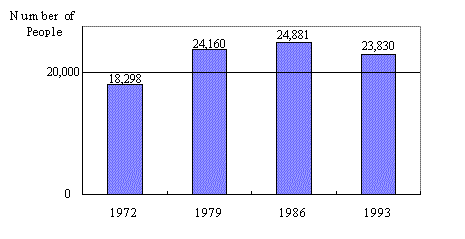 |
2. The number of Households
7,328 households [up 160 (2.2%)]
|
 |
3. The Ratio of Employment by Industry
 |
Primary industries 34.6%
(fisheries accounts for 22.2%)
|
 |
Secondary industries 32.4%
(construction accounts for 22.3%)
|
 |
Tertiary industries 32.0%
(service industry accounts for 13.1%)
|
 |
Others 1.0%
|
|
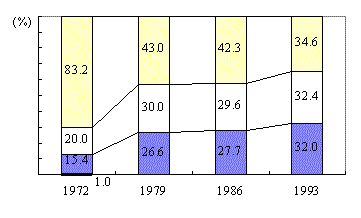 |
4. The Public Assistance Ratio
3.88% [Down 2.21 points]
|
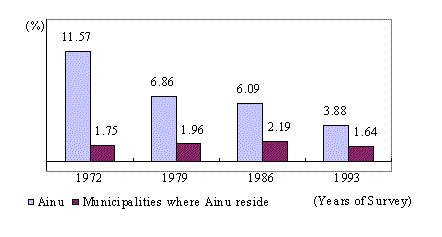 |
5. The Ratio of Students Who Go on to High School
87.4% [Up 9.0 points]
|
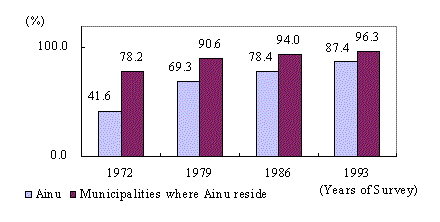 |
6. The Ratio of Students Who Go on to College
8% [Up 3.7 points]
|
 |
7. The Results of the Questionnaire Survey
| (1) | The necessity of measures for the Ainu people (%)

|
| (2) | The necessity of conservation and continuance of the Ainu culture (%)

|
| (3) | Recent experience of discrimination (last six to seven years)

Reference 3 for the details for the occasion of the discrimination infliction.
|
| (4) | The level of familiarity with the new Ainu Act which the Hokkaido Government is requesting the Government to propose for legislation (%)
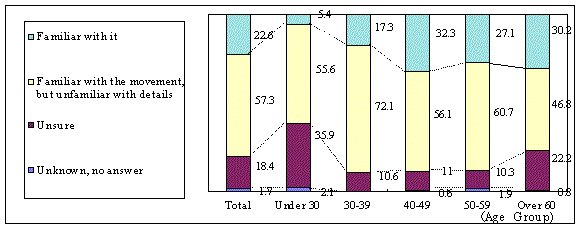 |
|
In this survey, "Ainu" refers to "people who are considered to be Ainu descendants in the local community, or those living with Ainu through marriage or adoption."
However, those who were considered to be Ainu descendants, but refused to be identified |
- [The Date of the Survey]
- June 1, 1993 (official publication in April, 1994)
[Categories of the Survey]
- Municipal Survey: a survey of the actual conditions of the population, the rate of employment, life and education conducted on the municipalities where the Ainu people reside
- District Survey: a survey of the conditions of the population, public assistance, taxes conducted on the districts of the municipalities where the Ainu people reside
- Household Survey: a survey of the conditions of families and income for three hundred households chosen at random
- Questionnaire: a questionnaire conducted on the household constituents over fifteen years of age among the households in the household survey
- [Previous Surveys]
- Surveys were conducted every seven years on three past occasions, in 1972, 1979 and 1986.
- About Discrimination Against the Ainu People
- To the question of "Have you experienced any form of discrimination within the last six to seven years?," 7.3% answered "I have experienced discrimination," 10.1% answered "I have not experienced it myself, but I know of somebody else who has," and 62% answered "I have not experienced discrimination," as shown in Table 67.
- To the question "Under what circumstances was the discrimination experienced?" which was given to those who answered either "I have experienced discrimination" or "I have not experienced it myself, but I know of somebody else who has," 42.0% answered "at school," 23.2% answered "marriage-related" and 17.9% answered "at the workplace," as shown in Table 68-1.
Table 67 Have you experienced any discrimination within the last six to seven years?
(%) |
Classification |
Ratio of the constituents
(642 persons) |
|
Actual number |
1. I have experienced discrimination. |
47 |
7.3 |
2. I have not experienced it myself, but I know of somebody else who has. |
65
|
10.1
|
3. I have not experienced discrimination. |
398 |
62.0 |
4. Unsure |
90 |
14.0 |
5. Unknown/no answer
| 42 |
6.6 |
|
Table 68-1 Under what circumstances was the discrimination experienced?
(%) |
Classification
|
Ratio of the constituents
(112 persons) |
1. During the hiring process |
9.8 |
2. At the workplace |
17.9 |
3. Marriage-related |
23.2 |
4. At school |
42.0 |
5. Relating to personal relationships |
10.7 |
6. From public administration (the national and local governments, including municipalities) |
0.9
|
7. Others
|
13.4
|
|
| *Multiple answers were possible. |
To the follow-up question of "What kind of discrimination was experienced?" which was given to those who answered either "I have experienced discrimination," or " I have not experienced it, but I know of somebody who has," 25% answered, "singled out as an Ainu and ridiculed," 17.0% answered, "Offers of marriage or dating were declined on the grounds of being an Ainu," and 6.3% answered, "physical features and looks were singled out," as shown in Table 68-2.
Table 68-2 What kind of discrimination was experienced?
(%) |
Classification
|
Ratio of the constituents
(112 persons) |
1. Offers of marriage or dating were declined on the grounds
of being an Ainu. |
17.0
|
2. Singled out as Ainu and ridiculed |
25.0 |
3. Physical features and looks were singled out |
6.3 |
4. Other |
18.8 |
5. No concrete mention
|
31.3
|
|
| *More than one answer was possible. |
To the question "What do you suggest to eliminate discrimination?" which was given to those who answered either "I have experienced discrimination" or "I have not experienced discrimination, but I know somebody else who has," 26.8% answered "achieve mutual understanding through discussions" and 18.8% answered "give proper education at educational facilities, including school and social education," as shown in Table 68-3.
Table 68-3 What do you suggest to eliminate discrimination?
(%) |
Classification
|
Ratio of the
constituents
(112 person) |
1. Give proper education at educational facilities, including school and social education |
18.8
|
2. Achieve understanding with informative activities |
5.4 |
3. Correct the gap in living standards |
1.8 |
4. Alleviate problems related to the lifestyles and attitudes of Ainu themselves |
5.4
|
5. Achieve mutual understanding through discussions |
26.8 |
6. Avoid coverage by the media |
1.8 |
7. Others |
6.3 |
8. No specific comments
|
34.8
|
|
| *More than one answer was possible. |
Back to Index









